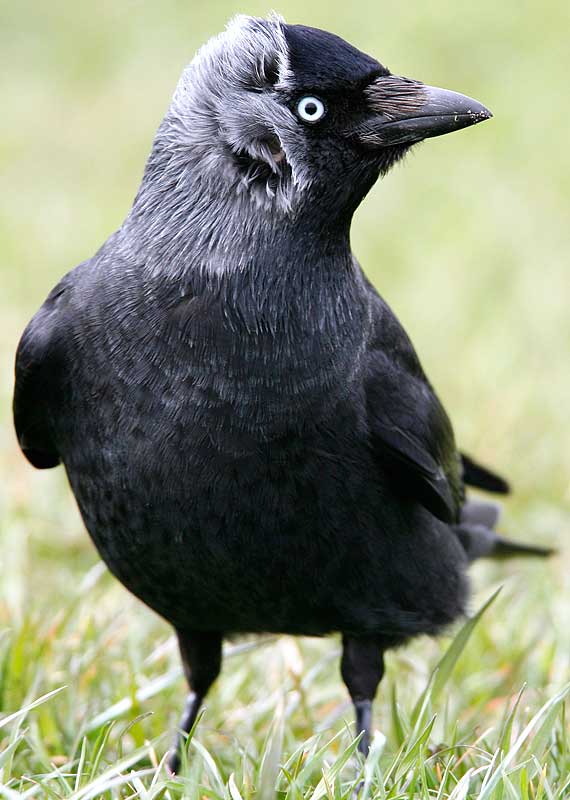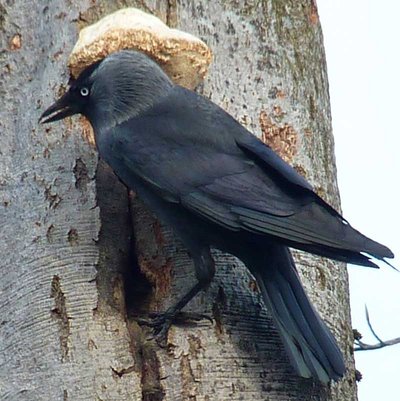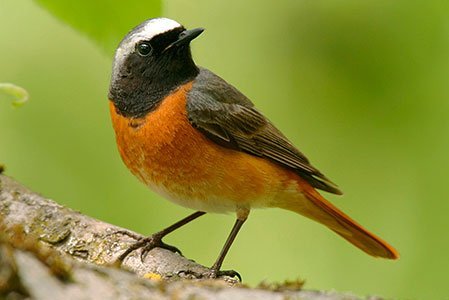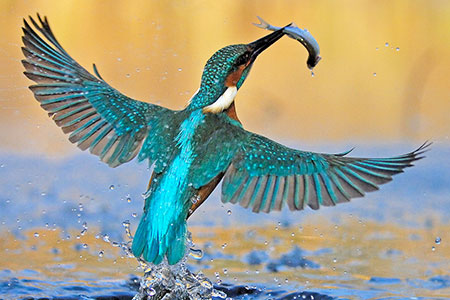The European jackdaw (Coloeus monedula), also known as the Eurasian jackdaw or western jackdaw, was the bird of the year 2012. In the vernacular in German, it sometimes also used to be called the “pastor's pigeon”. This common name seems an apt description, given its appearance, its pigeon-like flight pattern, and even its preferred choice of nesting place, often in church towers. Its dark plumage and black cap is reminiscent of the clothing of a village priest. It was classified Coloeus monedula by Linnaeus in the 18th century for its habit of picking up bright objects, especially coins (monedula being the same Latin stem, moneta, as money).
From the steppe to central Europe
The jackdaw is now widespread throughout Europe - from Spain and the Balkans, to the Yenisey Basin in the heart of Russia. It prefers warmer lowlands and is therefore absent from the rest of Russia and northern Scandinavia, as well as from mountainous areas above an altitude of 1,000 metres above sea level. There are currently around 100,000 breeding pairs in Germany. As a steppe bird, the jackdaw was first introduced to Central and Western Europe through human forest clearing activities.
Safe breeding sites in cavities
The jackdaw needs semi-open landscapes in which breeding sites and feeding habitats are closely interlinked. It is the only corvid species that breeds in cavities. However, cavities for birds the size of jackdaws are rare, and coveted by many species. It is therefore flexible in its choice of roosting sites, using rabbit burrows, rock crevices or large tree hollows, depending on what is available. The jackdaw prefers mature stands with several hollows, no further than one to two kilometres from the edge of the forest.
Its nesting site, whether in a smooth-barked beech or in a niche in a building, must offer protection from predators such as martens. It is also no problem for this acrobat to climb up to three metres deep into a chimney with the help of its outstretched wings, in order to build its nest as far away from the entrance as possible.
Loyal companions
Jackdaws prefer to breed in groups. Breeding colonies in forests are relatively small, with an average of five breeding pairs; colonies on buildings are usually larger. Jackdaws spend most of the year in the company of their conspecifics. More important than relatives, however, is their partner, whom they usually choose in their first year of life. A pair will usually remain faithful to each other for life, which can be up to 18 years in the wild. A change of partner is quite rare, and some birds remain faithful to each other even if they are not successful in breeding.
Forest planting and nesting territories
Males and females usually arrive at the chosen nesting site together from February onwards. They often use the same site for several years, renovating the nest when necessary. The partners recognise each other’s calls, although their song plays a relatively minor role in the annual courtship display. More important is the affected showing-off behaviour with which the male tries to convince the female of his qualities by stretching his neck and strutting in a very upright stance. If he is successful, she shows her readiness to mate with conspicuous tail trembling.
The jackdaw's nesting territory is very small, covering only the area in the immediate vicinity of the breeding crevice. From mid-April, four to six eggs are usually laid. These are incubated by the female for between 16 and 19 days.
Varied food sources
The young are fed on larger insects. For this, jackdaws need habitats with short-grass vegetation during the breeding season. Jackdaws are however omnivores. In addition to beetles, grasshoppers, worms, snails and small vertebrates, adult birds also feed on fresh shoots and seedlings, cereal grains, berries and fruit. On agricultural land, they use areas where the vegetation rarely exceeds a height of 15 to 20 centimetres or is patchy, e.g. harvested or freshly ploughed fields. Grazed or freshly mown grassland is particularly popular. Breeding colonies have a higher number of individual birds if they are surrounded by large areas of grassland. The reproductive success and vitality of the birds are also higher in varied rural agricultural landscapes than in cities, for example.
Highly developed social behaviour
There is a hierarchy within the breeding colony: mated birds are higher-ranked than unmated birds, and males are higher-ranking than females. However, females rise to share the rank of their partners upon pairing. They know the other birds in their flock and communicate with each other. This reduces fights over rank and nest territories to a minimum. There is great cohesion in the group. If necessary, the community raises the young, and the collective also feeds sick members of the flock.
When the young birds have left the nest, families also join the non-breeding groups. The flocks thus become larger from mid-June at the latest. In flocks they are safer, so that they can venture further out into open countryside with little cover in search of food. Now the jackdaws also like to join other corvids, especially rooks and crows, and form roosting colonies. In autumn and winter, these colonies are often joined by migrating or overwintering groups from northern and eastern Europe. The roosts are presumably important “information exchanges” - for the exchange of news on feeding grounds and for getting to know future life partners.
Jackdaws have a pronounced social learning behaviour. They not only learn through trial and error, but pass on the experience they have gained directly to their conspecifics. They also recognise cause-and-effect relationships with foresight and can adapt their behaviour again and again to new problems. In counting trials, they were able to find the correct containers with food using instruction boards shown to them beforehand, and were able to “count” to seven in the process. They estimate the depth of a cavity by dropping objects into it. They are also canny enough to let other species “pre-taste” unknown food sources.
Rapid habitat change
Even the most “intelligent” cultural successors no longer seem able to keep pace with the current rapid changes in agricultural land and settlement areas. This is indicated by the predominantly declining trend in the population of the jackdaw, which is now even threatened with extinction in Brandenburg. Whether it is a case of preserving feeding habitats in extensively farmed grassland, or breeding sites during building renovations: the welfare of this species now lies in our hands.





